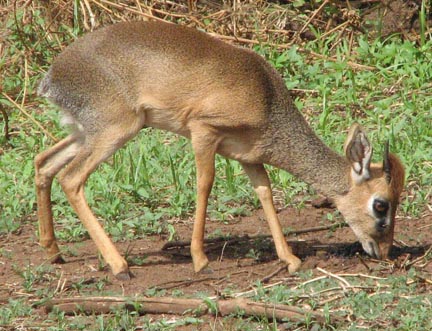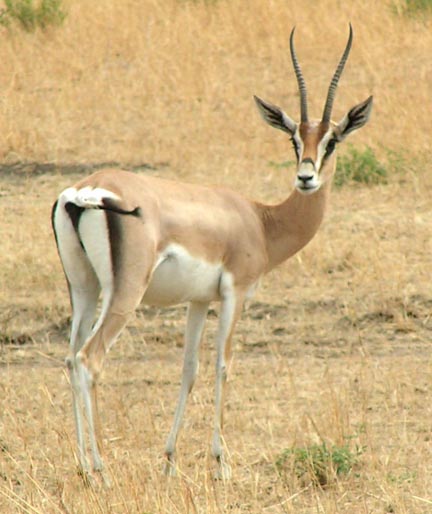Some of the animals we photographed in East Africa
|
Crocodile
|

|
|
Quickfacts
|
— most intelligent reptiles on earth
— only found in Africa and Madagascar
— wary of people and avoid contact with them.
— during dry spells bury themselves in the mud and hibernate
— very effective at waste disposal - digestive systems can handle rotting meat
|
|
|
|
Dik-dik
|

|
|
Quickfacts
|
— elongated snouts have bellows-like muscles - cool blood at high temperatures
— monogamous pairs - both care for young until next birth then kicked out
— long hunted - small leg bones for jewellery & skins made into suede gloves
— largely nocturnal, avoid heat of the day and unnecessary water loss.
— when disturbed - produces whistling sound through nose that sounds like "zik-zik"
|
|
|
|
Eland
|

|
|
Quickfacts
|
— largest antelopes of Africa - fully grown male may weigh over 700 kg
— associate often with zebras or giraffes - maybe to ward off lions
— use their horns to bring twigs and branches into reach
— animal most often depicted in early rock art of East Africa
— calves bond even stronger than those of a calf with its mother
|
|
|
|
Elephant
|

|
|
Quickfacts
|
— note: mammary glands are at the front
— African elephant has two finger-like structures at tip of trunk
— tusks are greatly elongated incisors (teeth)
— elephants are "right or left-tusked," - the favorite wears shorter
— teeth come in one at a time when the previous dies.
— lifespan 60 to 70 years - last molar at 25 when it wears out - starve
|
|
|
|
Grant's Gazelle
|

|
|
Quickfacts
|
— noticeably larger than Thomson’s gazelle - white (large patch) rump
— have ritualized postures such as “pretend” grooming warning males
— have harems with offspring and all-male bachelor groups - temporary
— typically remain in the open during the heat of the day
— lifespan 12 years - many predators
|
|
|
|
Thomson's Gazelle
|

|
|
Quickfacts
|
— smaller than the Grant's gazelle with black strip along side
— as the herd migrates, new territories are established with scent glands below eyes
— disturbed - stamps feet & contracts skin so black side stripe more obvious
— many predators - some feed on nothing else during the calving peaks.
— fine senses of hearing, sight and smell balance its vulnerability on the open plains
|
|

|